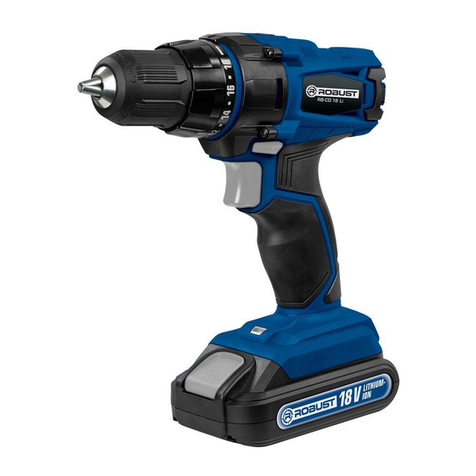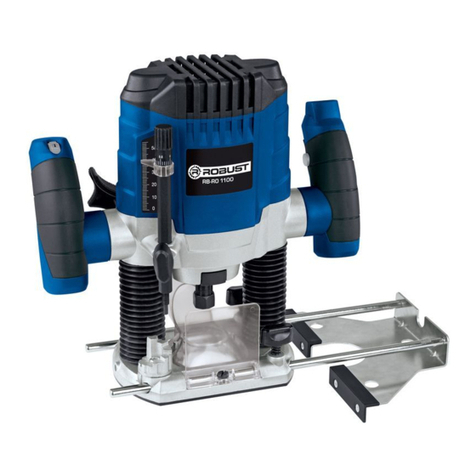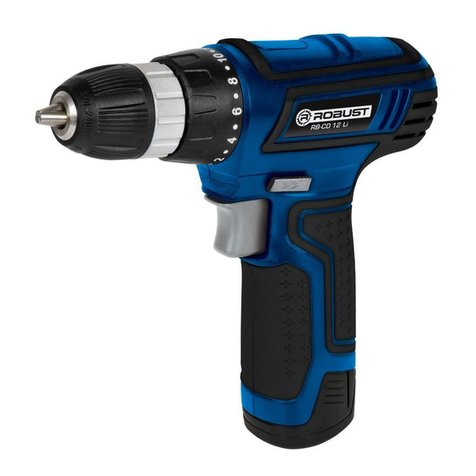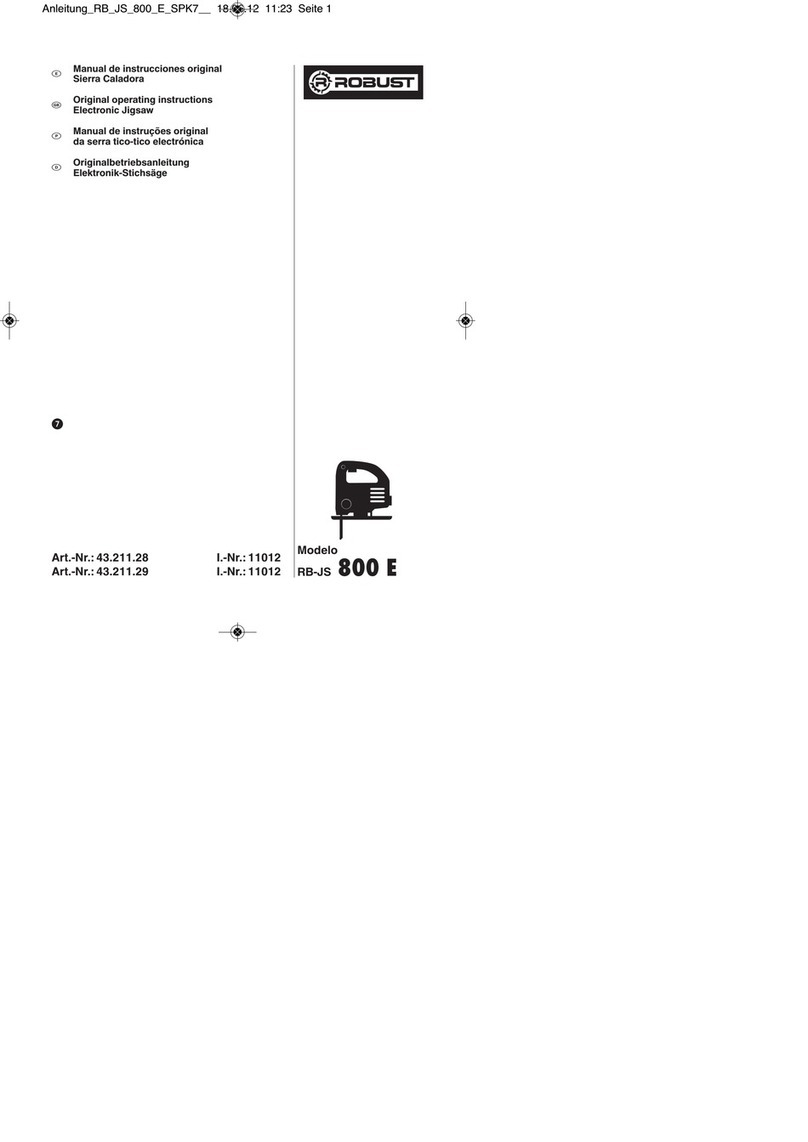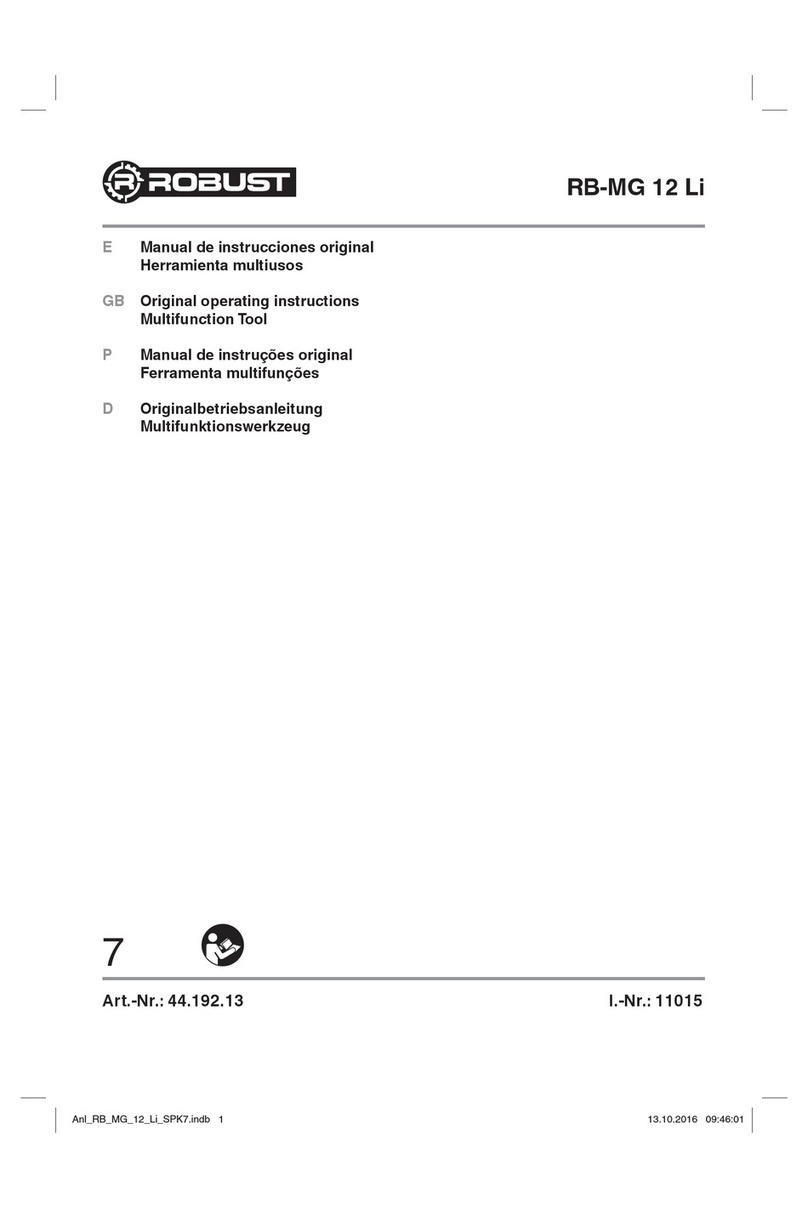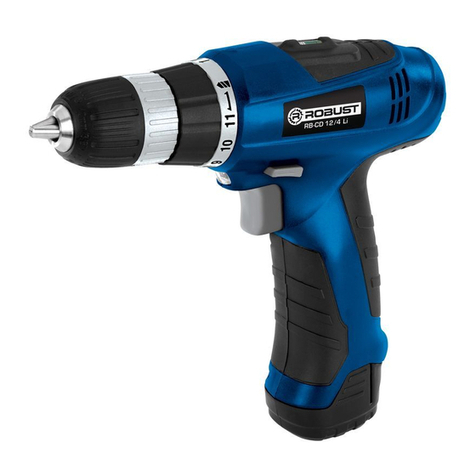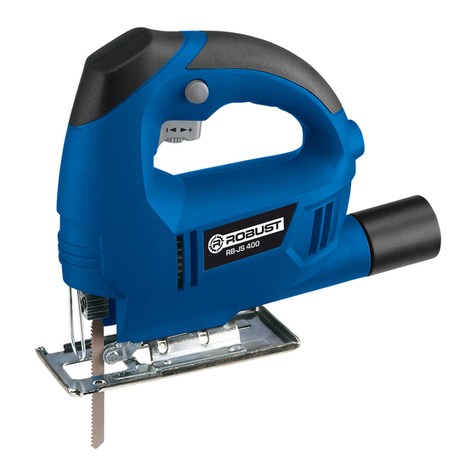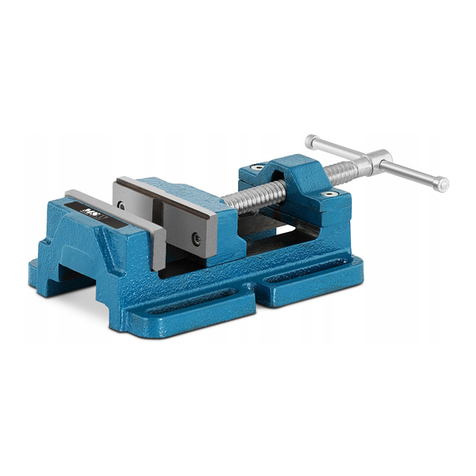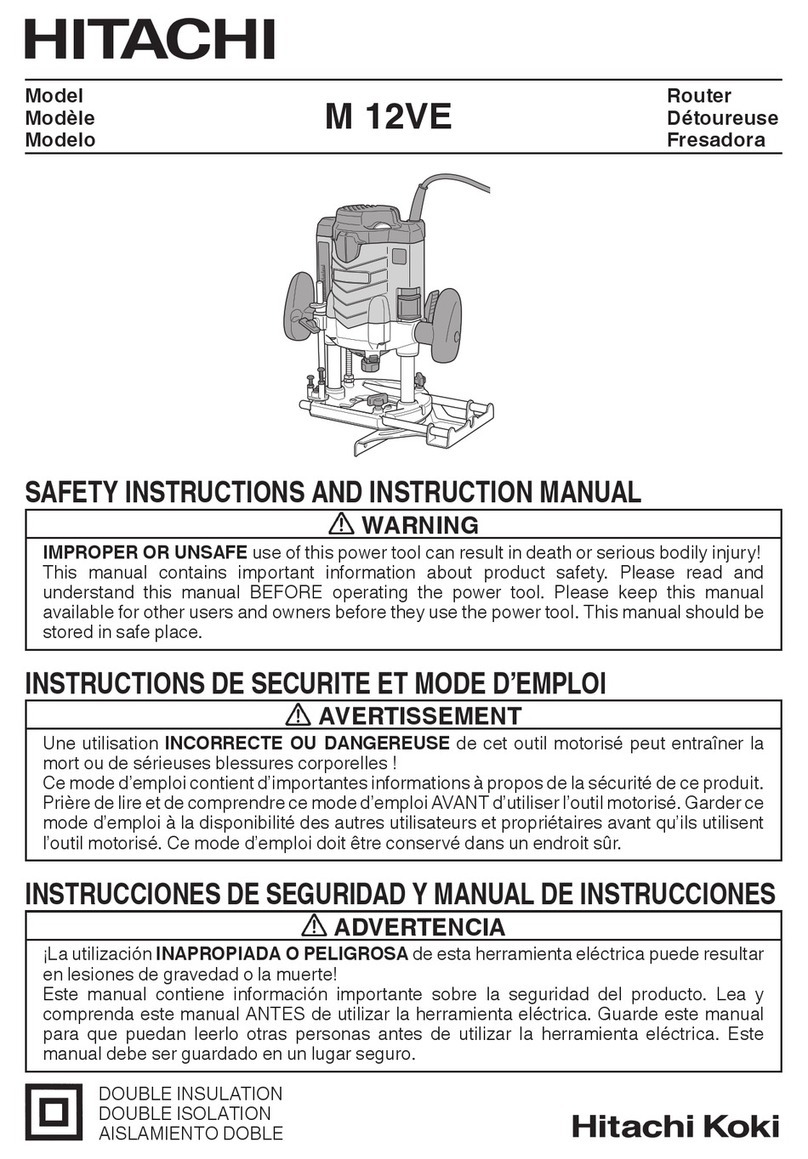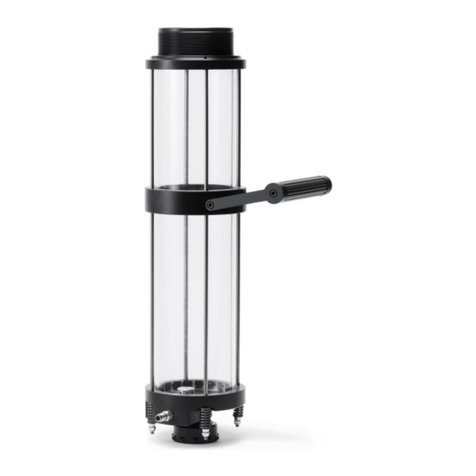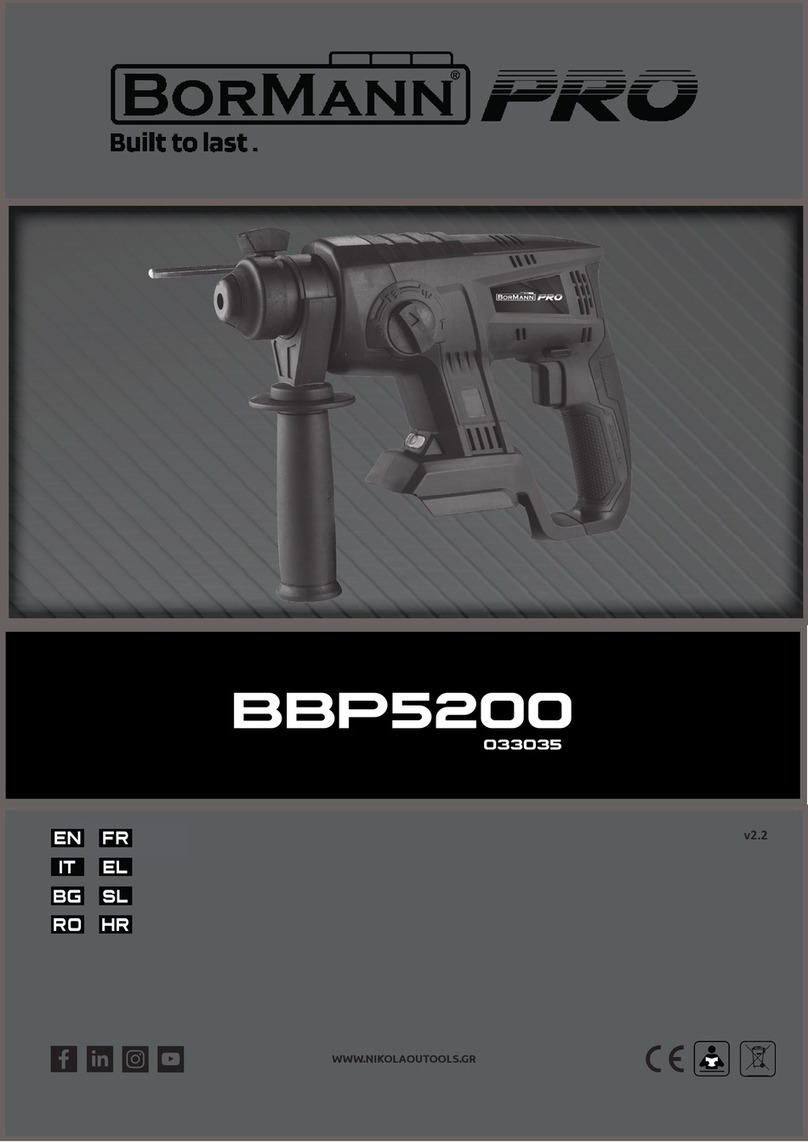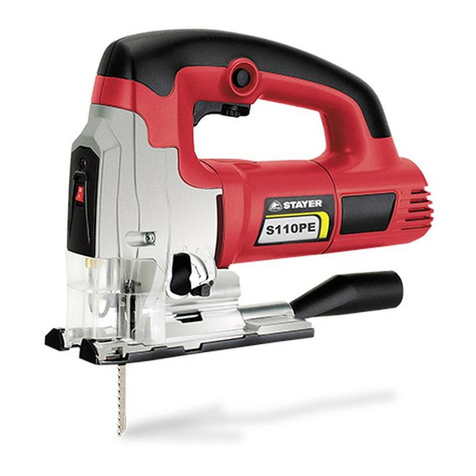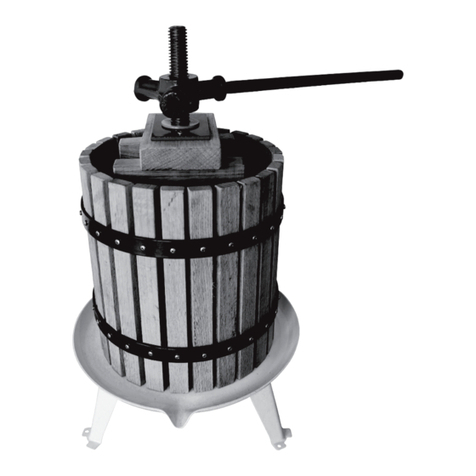Robust RB-MG 135 E User manual

Art.-Nr.: 44.191.48 I.-Nr.: 11013
Modelo RB-MG 135 E
7
EManual de instrucciones original
Mototool
GB Original operating instructions
Grinding and engraving tool
PManual de instruções original
Ferramenta para rectificar e gravar
DOriginalbetriebsanleitung
Schleif- und Gravur-Werkzeug
Anl_RB_MG_135_E.indb 1Anl_RB_MG_135_E.indb 1 27.01.14 11:0927.01.14 11:09

- 2 -
1
2
12 1
15
15 16
6
16
2
13
3
3
2
5
9
7
3
17
6
4
16
10
11
14
18 4
5
81
Anl_RB_MG_135_E.indb 2Anl_RB_MG_135_E.indb 2 27.01.14 11:0927.01.14 11:09

- 3 -
4 5
6
a
b
a
3
-
+
-
+
8 9
1
7
321
21
2 3 4
Anl_RB_MG_135_E.indb 3Anl_RB_MG_135_E.indb 3 27.01.14 11:0927.01.14 11:09

- 4 -
10 11
12
13b 14
1
13a
2 2 3 4
21 54321
54321 1
5
Anl_RB_MG_135_E.indb 4Anl_RB_MG_135_E.indb 4 27.01.14 11:0927.01.14 11:09

- 5 -
15
12 3 4 5 6
Anl_RB_MG_135_E.indb 5Anl_RB_MG_135_E.indb 5 27.01.14 11:0927.01.14 11:09

E
- 6 -
Aviso - Leer el manual de instrucciones para reducir cualquier riesgo de sufrir daños
Usar protección para los oídos. La exposición al ruido puede ser perjudicial para el oído.
Llevar gafas de protección. Durante el trabajo, la expulsión de chispas, astillas, virutas y polvo por el
aparato pueden provocar pérdida de vista.
Es preciso ponerse una mascarilla de protección. Puede generarse polvo dañino para la salud
cuando se realicen trabajos en madera o en otros materiales. ¡Está prohibido trabajar con material que
contenga asbesto!
Anl_RB_MG_135_E.indb 6Anl_RB_MG_135_E.indb 6 27.01.14 11:0927.01.14 11:09

E
- 7 -
¡Atención!
Al usar aparatos es preciso tener en cuenta una
serie de medidas de seguridad para evitar le-
siones o daños. Por este motivo, es preciso leer
atentamente este manual de instrucciones/adver-
tencias de seguridad. Guardar esta información
cuidadosamente para poder consultarla en cual-
quier momento. En caso de entregar el aparato
a terceras personas, será preciso entregarles,
asimismo, el manual de instrucciones/advertenci-
as de seguridad. No nos hacemos responsables
de accidentes o daños provocados por no tener
en cuenta este manual y las instrucciones de
seguridad.
1. Instrucciones de seguridad
¡Aviso!
Lea todas las instrucciones de seguridad e
indicaciones. El incumplimiento de dichas inst-
rucciones e indicaciones puede provocar descar-
gas, incendios y/o daños graves. Guarde todas
las instrucciones de seguridad e indicacio-
nes para posibles consultas posteriores.
Instrucciones generales de seguridad para
herramientas eléctricas
El término de “herramienta eléctrica” que se usa
en las instrucciones de seguridad se refiere a las
herramientas que funcionan en red (con cable de
conexión) y con batería (sin cable de conexión).
1. Seguridad en el lugar de trabajo
a) Mantener limpia y bien iluminada la zona
de trabajo. Las zonas de trabajo desordena-
das o sin luz pueden conllevar accidentes.
b) No trabajar con este aparato eléctrico en
un entorno explosivo en el que se hallen
líquidos, gases o polvos inflamables. Las
herramientas eléctricas generan chispas que
pueden inflamar el polvo o los vapores.
c) Mantener alejados a niños y a otras per-
sonas fuera del alcance de la herramienta
eléctrica. Las distracciones pueden hacer
perder el control sobre el aparato.
2. Seguridad eléctrica
a) El enchufe del aparato eléctrico debe ser
el adecuado para la toma de corriente.
El enchufe no debe ser modificado de
ningún modo. No emplear adaptadores
de enchufe con aparatos eléctricos pu-
estos a tierra. Los enchufes sin modificar y
las tomas de corriente adecuadas reducen el
riesgo de una descarga eléctrica.
b) Evitar el contacto corporal con superfi-
cies con toma de tierra como tubos, ca-
lefacciones, fogones y frigoríficos. Existe
un gran riesgo de descarga eléctrica si su
cuerpo se halla puesto a tierra.
c) Mantener los aparatos eléctricos alejados
de la lluvia o la humedad. Si entra agua en
el aparato eléctrico existirá mayor riesgo de
una descarga eléctrica.
d) No utilizar el cable de forma inadecuada,
no utilizarlo para transportar el aparato,
colgarlo o retirarlo de la toma de corri-
ente. Mantener el cable alejado del calor,
aceites, cantos afilados o partes del apa-
rato en movimiento. Los cables dañados o
mal enrollados aumentan el riesgo de descar-
ga eléctrica.
e) Si se trabaja con una herramienta eléctri-
ca al aire libre, emplear sólo alargaderas
que también sean adecuadas para el
exterior. El empleo de una alargadera apro-
piada para trabajos en el exterior reduce el
riesgo de descarga eléctrica.
f) Si no se puede evitar tener que utilizar la
herramienta eléctrica en un entorno húm-
edo, utilizar un dispositivo de protección
diferencial. El uso de un dispositivo de pro-
tección diferencial reduce el riesgo de sufrir
una descarga eléctrica.
3. Seguridad de personas
a) Prestar atención al trabajo, comprobar
lo que se está haciendo y proceder de
forma razonable durante el trabajo de
una herramienta eléctrica. No emplear la
herramienta eléctrica si se está cansado
o bajo la influencia de drogas, alcohol o
medicamentos. Una mínima falta de atenci-
ón durante el uso de la herramienta eléctrica
puede causar lesiones graves.
b) Llevar equipamiento de protección perso-
nal y siempre unas gafas protectoras. El
hecho de llevar equipamiento de protección
personal como mascarilla, calzado de segu-
ridad antideslizante, casco de protección o
protección para los oídos, según el tipo y uso
de la herramienta eléctrica, reduce el riesgo
de sufrir lesiones.
c) Evitar una puesta en marcha no intencio-
nada. Asegurarse de que la herramienta
está desconectada antes de enchufarla
a la red eléctrica y/o a la batería, tomarla
Anl_RB_MG_135_E.indb 7Anl_RB_MG_135_E.indb 7 27.01.14 11:0927.01.14 11:09

E
- 8 -
en la mano o transportarla. Peligro de sufrir
accidentes si la herramienta eléctrica se tras-
lada pulsando el interruptor o si se enchufa a
la toma de corriente cuando está encendida.
d) Retirar las herramientas de ajuste o la
llave antes de conectar la herramienta
eléctrica. Una herramienta o llave que se
haya olvidado en partes giratorias del aparato
puede producir lesiones.
e) Evitar trabajar en una posición corporal
inadecuada. Adoptar una posición segura
y mantener en todo momento el equilib-
rio. Ello permite controlar mejor la herramien-
ta eléctrica en situaciones inesperadas.
f) Llevar ropa de trabajo adecuada. No
llevar ropa holgada ni joyas durante el
trabajo. Mantener el cabello, la ropa y
los guantes alejados de las piezas en
movimiento. La ropa holgada, las joyas o los
cabellos largos pueden ser atrapados por las
piezas en movimiento.
g) Si el aparato permite instalar dispositi-
vos de aspiración y recogida del polvo,
es preciso asegurarse de que estén
conectados y se empleen de forma cor-
recta. La utilización de un aspirador de polvo
puede reducir los peligros provocados por el
mismo.
4. Empleo y tratamiento de la herramienta
eléctrica
a) No sobrecargar el aparato. Usar la herra-
mienta eléctrica específica para cada tra-
bajo. Con la herramienta eléctrica adecuada
se trabaja mejor y con más seguridad per-
maneciendo dentro de la potencia indicada.
b) No usar ninguna herramienta eléctrica
cuyo interruptor esté defectuoso. Una her-
ramienta eléctrica que ya no pueda conectar-
se o desconectarse conlleva peligros y debe
repararse.
c) Desenchufar el cable de la toma de corri-
ente y/o retirar la batería antes de ajustar
el aparato, cambiar accesorios o abando-
nar el aparato. Esta medida de seguridad
evita que la herramienta eléctrica arranque
accidentalmente.
d) Guardar las herramientas eléctricas que
no se usen fuera del alcance de los niños.
No permitir el uso del aparato a perso-
nas que no estén familiarizadas con él o
no hayan leído estas instrucciones. Las
herramientas eléctricas son peligrosas si las
usan personas sin experiencia.
e) Cuidar la herramienta eléctrica de forma
adecuada. Comprobar que las piezas
móviles funcionen de forma correcta y no
se bloqueen, controlar también si existen
piezas rotas o están tan dañadas que
ponen en peligro el funcionamiento de la
herramienta eléctrica. Reparar las piezas
dañadas antes de usar el aparato. Nume-
rosos accidentes se deben a herramientas
eléctricas mal cuidadas.
f) Mantener limpias y afiladas las herrami-
entas de corte. Las herramientas de corte
bien cuidadas con cantos afilados se bloque-
an con menor frecuencia y pueden manejar-
se de forma más sencilla.
g) Respetar estas instrucciones cuando se
desee utilizar la herramienta eléctrica, los
accesorios, piezas de recambio, etc. Para
ello, tener en cuenta las condiciones de
trabajo y la tarea a ejecutar. El uso de her-
ramientas eléctricas para otros fines diferen-
tes a los previstos puede originar situaciones
peligrosas.
5. Servicio
a) Sólo especialistas cualificados deben re-
parar la herramienta eléctrica, empleando
para ello únicamente piezas de repuesto
originales. Esta forma de proceder garantiza
la seguridad de la herramienta eléctrica.
Instrucciones de seguridad especiale
• Use el aparato sólo para lijar en seco.
• Tire del cable siempre hacia atrás para que
se mantenga en la parte trasera del aparato
en todo momento.
• No se deben trabajar materiales que conten-
gan asbesto.
• ¡Antes de todo trabajo en la máquina (limpie-
za, cambio de papel abrasivo, etc.) se debe
desconectar de la red!
• Desconecte el cable de red de la toma de
corriente, tirando siempre del enchufe.
• El puesto de trabajo debe ser limpio y bien
iluminado.
• Cuido de que la pieza a trabajar esté bien fija.
• Mantenga alejados los niños del lugar de
trabajo.
• En interés propio, mantenga siempre la
máquina limpia y después de los trabajos
efectúe un control respecto a posibles dete-
rioros.
• Asegurese que al conectar la máquina a la
red el interruptor esté desconectado.
• Cuide de un apoyo firme, ante todo en esca-
Anl_RB_MG_135_E.indb 8Anl_RB_MG_135_E.indb 8 27.01.14 11:0927.01.14 11:09

E
- 9 -
leras y andamios.
• Al trabajar madera o metal previamente
tratados pueden generarse polvos tóxicos o
nocivos.
• El contacto o aspiración de estos polvos
puede representar un peligro para el operario
o las personas que se encuentren en las in-
mediaciones.
• Por razones de salud, para trabajar utilice
siempre una mascarilla protectora del polvo y
unas gafas adecuadas.
• Si determina deterioros, en base a los dibujos
de montaje desarmado así como la lista de
piezas, defina exactamente los repuestos y
solicítelos al servicio postventa.
• ¡Atención! ¡Utilice gafas de protección y
máscara contra el polvo!
Guardar las instrucciones de seguridad en
lugar seguro.
2. Descripción del aparato y
volumen de entrega
2.1 Descripción del aparato (fig. 3)
1 Interruptor ON/OFF
2 Regulador de velocidad
3 Tuerca de regulación
4 Botón de retención para portabrocas
5 Cubierta
2.2 Volumen de entrega (fig. 1/2/3)
• Abrir el embalaje y extraer cuidadosamente
el aparato.
• Retirar el material de embalaje, así como los
dispositivos de seguridad del embalaje y para
el transporte (si existen).
• Comprobar que el volumen de entrega esté
completo.
• Comprobar que el aparato y los accesorios
no presenten daños ocasionados durante el
transporte.
• Si es posible, almacenar el embalaje hasta
que transcurra el periodo de garantía.
Atención!
¡El aparato y el material de embalaje no son
un juguete! ¡No permitir que los niños jue-
guen con bolsas de plástico, láminas y pie-
zas pequeñas! ¡Riesgo de ingestión y asfixia!
• Maletín
• Muelas de lijar
• Cintas abrasivas
• Mandriles de sujeción
• Fresa
• Pulidora de fieltro / Mandriles de sujeción
• Brocas
• Unidad motriz
• Barritas de abrasivo
• Muelas de lijar
• Manguitos de sujeción
• Muelas de tronzar
• Eje flexible
• Sujeción para mesa
• Barra soporte telescópica
• Cilindros esmeriladores
• Cepillos de alambre
• Manual de instrucciones original
3. Uso adecuado
El juego de desbarbadora y grabadora se ha
diseñado para taladrar, lijar, desbarbar, pulir, gra-
bar, cortar, fresar y para la limpieza de madera,
metal y materiales sintéticos utilizados en la fab-
ricación de modelos y maquetas, taller y menaje.
Utilice la herramienta y los accesorios sólo para
las aplicaciones descritas.
Utilizar la máquina sólo en los casos que se indi-
can explícitamente como de uso adecuado. Cual-
quier otro uso no será adecuado. En caso de uso
inadecuado, el fabricante no se hace responsable
de daños o lesiones de cualquier tipo; el respon-
sable es el usuario u operario de la máquina.
Tener en consideración que nuestro aparato no
está indicado para un uso comercial, industrial o
en taller. No asumiremos ningún tipo de garantía
cuando se utilice el aparato en zonas industria-
les, comerciales o talleres, así como actividades
similares.
4. Características técnicas
Tensión de red: .............................. 110 V ~ 60 Hz
Consumo de energía: ............................... 135 W
Velocidad en vacío n0:.. máx. 10.000-32.000 min-1
Capacidad de sujeción ....... 0,5-3,2 mm/0,02“-1/8“
A prueba de sacudidas eléctricas.................II / 쓑
Peso: ........................................................0,61 kg
Anl_RB_MG_135_E.indb 9Anl_RB_MG_135_E.indb 9 27.01.14 11:0927.01.14 11:09

E
- 10 -
Ruido y vibración
Los valores con respecto al ruido y la vibración se
determinaron conforme a la norma EN 60745.
Nivel de presión acústica LpA .............. 68,5 dB(A)
Imprecisión KpA ............................................3 dB
Nivel de potencia acústica LWA ........... 79,5 dB(A)
Imprecisión KWA ............................................3 dB
Usar protección para los oídos.
La exposición al ruido puede ser perjudicial para
el oído.
Los valores totales de vibración (suma de vec-
tores en las tres direcciones) se determinaron
conforme a la norma EN 60745.
Valor de emisión de vibraciones ah≤2,5 m/s2
Imprecisión K = 1,5 m/s2
¡Aviso!
El valor de emisión de vibraciones indicado se
ha calculado conforme a un método de ensayo
normalizado, pudiendo, en algunos casos excep-
cionales, variar o superar el valor indicado depen-
diendo de las circunstancias en las que se utilice
la herramienta eléctrica.
El valor de emisión de vibraciones indicado pue-
de utilizarse para comparar la herramienta con
otras.
El valor de emisión de vibraciones indicado tam-
bién puede utilizarse para una valoración prelimi-
nar de los riesgos.
¡Reducir la emisión de ruido y las vibracio-
nes al mínimo!
• Emplear sólo aparatos en perfecto estado.
• Realizar el mantenimiento del aparato y limpi-
arlo con regularidad.
• Adaptar el modo de trabajo al aparato.
• No sobrecargar el aparato.
• En caso necesario dejar que se compruebe
el aparato.
• Apagar el aparato cuando no se esté utilizan-
do.
• Llevar guantes.
Riesgos residuales
Incluso si esta herramienta se utiliza adecua-
damente, siempre existen riesgos residuales.
En función de la estructura y del diseño de
esta herramienta eléctrica pueden producir-
se los siguientes riesgos:
1. Lesiones pulmonares en caso de que no se
utilice una mascarilla de protección antipolvo.
2. Lesiones auditivas en caso de que no se utili-
ce una protección para los oídos adecuada.
3. Daños a la salud derivados de las vibracio-
nes de las manos y los brazos si el aparato
se utiliza durante un largo periodo tiempo, no
se sujeta del modo correcto o si no se realiza
un mantenimiento adecuado.
5. Antes de la puesta en marcha
5.1 Extracción de los accesorios (fig. 4)
Para poder extraer los accesorios, tirar hacia arri-
ba (a) de su soporte.
5.2 Colocación de las diferentes herramien-
tas (fig. 3)
Antes de colocar las herramientas en su sitio
(y antes de cada cambio de herramientas), de-
berá apagar y desenchufar la unidad motriz.
1. Presionar el perno de retención (4) y girar el
portabrocas hasta que el perno se quede
enclavado.
2. Soltar la tuerca portabrocas (3).
3. Colocar la herramienta escogida hasta el tope
del manguito de sujeción y atornillar la tuerca
portabrocas (3).
5.3 Montaje del árbol flexible (fig. 3/5)
• Desatornillar la cubierta (5) en la parte delan-
tera del aparato.
• Soltar la tuerca portabrocas (3).
• Introducir el eje interior (a) del árbol flexible
en la tuerca portabrocas (3).
• Apretar la tuerca portabrocas (3).
• A continuación, atornillar el anillo (b) a la lija-
dora múltiple.
5.3.1 Colocación de las distintas herramien-
tas en el árbol flexible
1. Introducir la clavija de retención suministrada
(18) en la perforación del eje flexible (13) y
girar el eje hasta que la clavija encaje.
2. A continuación, soltar la tuerca portabrocas.
3. Colocar la herramienta escogida hasta el
tope del manguito de sujeción y apretar la
tuerca del portabrocas
Anl_RB_MG_135_E.indb 10Anl_RB_MG_135_E.indb 10 27.01.14 11:0927.01.14 11:09

E
- 11 -
5.4 Uso del soporte (fig. 6)
• Fije el soporte a un banco de trabajo
• El soporte se ajusta en altura pudiendo re-
gularse
• según se indica en la fig. 6.
• A continuación se puede sujetar la lijadora
• múltiple al soporte.
6. Puesta en marcha
• Asegúrese de que la unidad motriz esté
desconectada.
• Compruebe que la tensión de red coincide
con la especificada en la placa de identifica-
ción del aparato. Enchufe el aparato.
6.1 Interruptor ON/OFF (fig. 3)
Conectar la unidad motriz con el interruptor de
red (1).
6.2 Regulador de velocidad (fig. 3)
Se puede ajustar la velocidad deseada por medio
del regulador (2).
La velocidad ideal depende de la herramienta
acoplada y del material a trabajar.
6.3 Instrucciones para el ajuste de la
velocidad
• herramientas de fresado pequeñas/muelas
de espiga: alta velocidad
• herramientas de fresado grandes/muelas de
espiga: escasa velocidad
6.4 Instrucciones relativas al trabajo
• Ejerza una presión moderada sólo sobre la
pieza que desea trabajar para asegurar una
velocidad de rotación igual mientras trabaja.
• Una mayor presión no acelera el proceso de
trabajo, sino que frena o detiene la unidad
motriz y, con ello, provoca la sobrecarga del
motor.
• Para su seguridad personal, fije las piezas
pequeñas mediante un tornillo de banco o de
apriete
• Trabajos de precisión y grabados: sujete la
unidad motriz como si fuera un bolígrafo
• trabajos en grueso: sujete la unidad motriz
como si fuera el mango de un martillo
7. Accesorios
7.1 Accesorios (fig. 7/fig. 1; pos. 2-3)
1 Muela de lijar
2 Cinta abrasiva (pequeña)
3 Cinta abrasiva (grande)
7.2 Accesorios (fig. 8. / fig. 1; pos. 12 )
1 Muela de tronzar (fina)
2 Muela de tronzar (grande)
7.3 Accesorios (fig. 9 / fig. 1; pos. 5)
1 Fresa (cilindro, grande)
2 Fresa (cilindro, pequeña)
3 Fresa (punta)
4 Fresa (bola)
7.4 Accesorios (fig. 10 / fig. 1; pos. 2/6)
1 Muela de lijar
2 Muela pulidora de fieltro
7.5 Accesorios (fig. 11 / fig. 1; pos. 9)
1-5 Barritas de abrasivo
7.6 Accesorios (fig. 12 / fig. 1; pos. 4/16/17)
1 Muela de tronzar de diamante
2 Mandril de sujeción para muela de tronzar de
diamante
3 Cilindro esmerilador para cintas abrasivas
(pequeño)
4 Cilindro esmerilador para cintas abrasivas
(grande)
5 Cepillos de copa
7.7 Accesorios (fig. 13 / fig. 1; pos. 5/11)
1 Manguito de sujeción 0,6-3,2 mm
2 Fresa
7.8 Accesorios (fig. 14 /fig. 1; pos. 4/6/10)
1 Mandril de sujeción para muelas de fieltro
2 Mandril de sujeción para muelas de lijar
3 Muela pulidora de fieltro
4 Muela pulidora de fieltro
5 Muela de lijar
7.9 Accesorios (fig. 15 / fig. 1; pos. 7)
1-6 Brocas (1-3 mm)
7.10 Descripción de los accesorios:
Muelas de tronzar:
Para cortar metales y plásticos. Para ello, debe
fijar la muela para tronzar en el mandril de suje-
ción.
Anl_RB_MG_135_E.indb 11Anl_RB_MG_135_E.indb 11 27.01.14 11:0927.01.14 11:09

E
- 12 -
Barritas de abrasivo:
En diferentes formas de cabezal. Para lijar y
desbarbar metal y plástico.
Broca HSS:
Para taladrar metal no férreo, madera, plástico y
placas de circuito impreso.
Muelas para lijar:
Para limpiar y afilar cuchillos y herramientas. Para
ello, fije la muela en el mandril de sujeción.
Hoja lijadora:
Para lijar y desbarbar madera y plásticos.
Muelas de pulir/puntas de pulir:
Para pulir latón, cinc, cobre, etc. Se pueden com-
binar con pastas para pulir.
Cepillos de alambre:
Para limpiar piedra, metal, aluminio, etc.
Cintas abrasivas:
Para lijar madera y plástico.
Muela de tronzar diamantada:
Para cortar, tronzar, lijar y desbarbar materiales,
como, p. ej. hormigón, piedra, porcelana, cerámi-
ca, etc.
Manguitos de sujeción:
Diversos tamaños para sujetar distintos tipos de
accesorios.
Fresa:
Para fresar plástico, madera y metal blando
Llave portabrocas
Para montar los accesorios
8. Mantenimiento, limpieza y pedido
de piezas de repuesto
Desenchufar siempre antes de realizar algún tra-
bajo de limpieza.
8.1 Limpieza
• Reducir al máximo posible la suciedad y
el polvo en los dispositivos de seguridad,
las rendijas de ventilación y la carcasa del
motor. Frotar el aparato con un paño limpio o
soplarlo con aire comprimido manteniendo la
presión baja.
• Se recomienda limpiar el aparato tras cada
uso.
• Limpiar el aparato con regularidad con un
paño húmedo y un poco de jabón blando. No
utilizar productos de limpieza o disolventes ya
que se podrían deteriorar las piezas de plá-
stico del aparato. Es preciso tener en cuenta
que no entre agua en el interior del aparato.
8.2 Escobillas de carbón
En caso de formación excesiva de chispas,
ponerse en contacto con un electricista espe-
cializado para que compruebe las escobillas de
carbón.¡Atención! Las escobillas de carbón sólo
deben ser cambiadas por un electricista.
8.3 Mantenimiento
No hay que realizar el mantenimiento a más
piezas en el interior del aparato.
9. Eliminación y reciclaje
El aparato está protegido por un embalaje para
evitar daños producidos por el transporte. Este
embalaje es materia prima y, por eso, se puede
volver a utilizar o llevar a un punto de reciclaje.
El aparato y sus accesorios están compuestos de
diversos materiales, como, p. ej., metal y plástico.
Depositar las piezas defectuosas en un contene-
dor destinado a residuos industriales. Informarse
en el organismo responsable al respecto en su
municipio o en establecimientos especializados.
10. Almacenamiento
Guardar el aparato y sus accesorios en un
lugar oscuro, seco, protegido de las heladas e
inaccesible para los niños. La temperatura de
almacenamiento óptima se encuentra entre los
5 y 30 ˚C. Guardar la herramienta eléctrica en su
embalaje original.
Anl_RB_MG_135_E.indb 12Anl_RB_MG_135_E.indb 12 27.01.14 11:0927.01.14 11:09

E
- 13 -
Sólo está permitido copiar la documentación y documentos anexos del producto, o extractos de los
mismos, con autorización expresa de iSC GmbH.
Nos reservamos el derecho a realizar modificaciones técnicas
Anl_RB_MG_135_E.indb 13Anl_RB_MG_135_E.indb 13 27.01.14 11:0927.01.14 11:09

GB
- 14 -
Caution - Read the operating instructions to reduce the risk of inquiry
Wear ear-muffs. The impact of noise can cause damage to hearing.
Wear safety goggles. Sparks generated during working or splinters, chips and dust emitted by the de-
vice can cause loss of sight.
Wear a breathing mask. Dust which is injurious to health can be generated when working on wood
and other materials. Never use the device to work on any materials containing asbestos!
Anl_RB_MG_135_E.indb 14Anl_RB_MG_135_E.indb 14 27.01.14 11:0927.01.14 11:09

GB
- 15 -
Important!
When using the equipment, a few safety pre-
cautions must be observed to avoid injuries and
damage. Please read the complete operating
instructions and safety regulations with due care.
Keep this manual in a safe place, so that the in-
formation is available at all times. If you give the
equipment to any other person, hand over these
operating instructions and safety regulations as
well.We cannot accept any liability for damage
or accidents which arise due to a failure to follow
these instructions and the safety instructions.
1. Safety regulations
Caution!
Read all safety regulations and instructions.
Any errors made in following the safety regula-
tions and instructions may result in an electric
shock, fire and/or serious injury.
Keep all safety regulations and instructions
in a safe place for future use.
General safety instructions for electric tools
The term “electric tool” used in the safety inst-
ructions refers to electric tools operated from the
mains power supply (with a power cable) and to
battery operated electric tools (without a power
cable).
1. Workplace safety
a) Keep your work area clean and well illu-
minated. Untidy or unlit work areas can result
in accidents.
b) Do not operate the electric tool in an en-
vironment where there is a risk of explo-
sions and where there are inflammable
liquids, gases or dust. Electric tools produ-
ce sparks which could set the dust or vapours
alight.
c) Keep the electric tool out of the reach of
children and other persons. If there is a
distraction, you may lose control of the appli-
ance.
2. Electrical safety
a) The connector plug from this electric tool
must fit into the socket.The plug should
never be altered in any way. Never use ad-
apter plugs together with earthed electric
tools. Unaltered plugs and correct sockets
reduce the risk of an electric shock.
b) Avoid bodily contact with earthed sur-
faces such as pipes, heating, ovens and
fridges. The risk of electric shock is increa-
sed if your body is earthed.
c) Keep the tool out of the rain and away
from moisture. The ingress of water into an
electric tool increases the risk of an electric
shock.
d) Do not use the cable to carry the electric
tool, to hang it up or to pull it out of the
socket. Keep the cable away from heat,
oil, sharp edges and moving parts of the
appliance. Damaged or entangled cables
increase the risk of an electric shock.
e) If you are working outdoors with an elec-
tric tool, only use extension cables which
are designed specifically for this purpose.
Using specially designed outdoor extension
cables, the risk of electric shock is reduced.
f) If operation of the electric tool in a damp
environment can not be avoided, use a
earth-leakage circuit-breaker. The earth-
leakage circuit-breaker reduces the risk of an
electric shock.
3. Safety of persons
a) Be careful, watch what you are doing and
use an electric tool sensibly. Do not use
the tool if you are tired or under the influ-
ence of drugs, alcohol or medication. A
moment of inattention when using the electric
tool can result in serious injuries.
b) Wear personal protection equipment
and always wear safety goggles. Wearing
personal protection (such as dust masks,
non-slip safety shoes, safety helmet or ear
protection, depending upon the type and use
of the electric tool) reduces the risk of injury.
c) Make sure that the appliance cannot start
up accidentally. Ensure that the electric
tool is switched offbefore you connect
it to the power supply and/or insert the
battery, or pick up or carry the tool. If your
finger is on the switch whilst carrying the elec-
tric tool or if you connect the appliance to the
mains when it is switched on, this can lead to
accidents.
d) Remove keys and wrenches before swit-
ching on the electric tool. A tool or key
which comes into contact with rotating parts
of the appliance can lead to injuries.
e) Avoid abnormal working postures. Make
sure you stand squarely and keep your
balance at all times. In this way, you can
control the electric tool better in unexpected
Anl_RB_MG_135_E.indb 15Anl_RB_MG_135_E.indb 15 27.01.14 11:0927.01.14 11:09

GB
- 16 -
circumstances.
f) Wear suitable work clothes. Do not wear
loose clothing or jewellery. Keep hair, clo-
thes and gloves away from moving parts.
Loose clothing, jewellery or long hair can get
trapped in moving parts.
g) If vacuuming devices and draining de-
vices can be fitted, make sure that these
are correctly attached and correctly used.
The use of a dust extraction system can redu-
ce the danger posed by dust.
4. Usage and treatment of the electric tool
a) Do not overload the appliance. Use the
correct tool for your work. You will be able
to work better and more safely within the gi-
ven performance boundaries.
b) Do not use an electric tool with a defec-
tive switch. An electric tool that cannot be
switched on or offis dangerous and must be
repaired.
c) Pull the plug out of the socket and/or
remove the battery before making any ad-
justments to the appliance, changing ac-
cessories or put the appliance down. This
safety measure prevents starting the electric
tool unintentionally.
d) Keep unused electric tools out of the
reach of children. Do not allow people
who are not familiar with the appliance or
who have not read these instructions to
use the appliance. Electric tools are dange-
rous if they are used by inexperienced people.
e) Clean your electric tool carefully. Check
whether moving parts are functioning
properly and not jamming, whether parts
are broken or damaged enough that the
functioning of this electric tool is affec-
ted. Have damaged parts repaired before
using the appliance. Many accidents are
caused by badly maintained electric tools.
f) Keep your cutting tools sharp and clean.
Carefully maintained cutting tools with sharp
cutting edges will jam less and are easier to
control.
g) Make sure to use electric tools, accesso-
ries, attachments, etc. in accordance with
these instructions. Take the conditions in
your work area and the job in hand into
account. Using electric tools for any purpose
other than the one for which they are intended
can lead to dangerous situations.
5. Service
a) Have your electric tool repaired only by
trained personnel using only genuine
spare parts.This will ensure that your elec-
tric tool remains safe to use.
Additional safety instructions
• This tool may only be used for dry grinding/
sanding operations.
• Always guide the power cable away from the
back of the tool.
• Use of the tool on materials containing asbes-
tos is prohibited.
• Always remove the plug from the power sup-
ply socket before carrying out any work on the
machine (cleaning the sander, changing the
sandpaper, etc.).
• Always disconnect the machine by removing
the plug from the socket, not by pulling on the
power cable.
• Keep your workplace clean and well illumi-
nated.
• Make sure that the workpiece is sufficiently
secured so that it cannot slip.
• Keep children away.
• For your own sake, keep the machine clean
at all times and check it for signs of damage
each time after using it.
• Make sure that the switch is set to OFF befo-
re you insert the plug into the power supply
socket.
• Make sure of your footing, particularly when
working on ladders and platforms.
• Harmful or toxic dust can be produced when
working on wood or metal.
• Touching or inhaling this dust can be harmful
for the operator and other persons nearby.
• To protect your health, always wear safety
goggles and a dust mask during sanding/
grinding work!
• If you discover any damage to the machine,
use the exploded diagram and the spare
parts list to determine which parts need to be
ordered from Customer Service.
• Important! Wear safety goggles and a
dust mask.
Do not lose these safety instructions.
Anl_RB_MG_135_E.indb 16Anl_RB_MG_135_E.indb 16 27.01.14 11:0927.01.14 11:09

GB
- 17 -
2. Layout and items supplied
2.1 Layout (Fig. 3)
1 On/Offswitch
2 Speed controller
3 Clamp nut
4 Locking knob for collet chuck
5 Cover
2.2 Items supplied (Fig. 1/2/3)
• Open the packaging and take out the equip-
ment with care.
• Remove the packaging material and any
packaging and/or transportation braces (if
available).
• Check to see if all items are supplied.
• Inspect the equipment and accessories for
transport damage.
• If possible, please keep the packaging until
the end of the guarantee period.
Important!
The equipment and packaging material are
not toys. Do not let children play with plastic
bags, foils or small parts. There is a danger of
swallowing or suffocating!
• Case
• Grinding disks
• Grinding belts
• Clamping spindles
• Cutters
• Felt polishers / arbors
• Drill bits
• Drive unit
• Grinding pins
• Grinding disks
• Clamping sleeves
• Cutting wheels
• Flexible shaft
• Table clamp
• Telescopic stand rod
• Grinding heads
• Wire brushes
• Original operating instructions
3. Proper use
The Grinding and Engraving Set is designed to
perform drilling, grinding, deburring, polishing,
engraving, cutting, milling and cleaning jobs
on wood, metal and plastic in model-making,
workshop and household applications. Use the
tool and accessories only for those applications
described.
The equipment is to be used only for its prescri-
bed purpose. Any other use is deemed to be a
case of misuse.The user / operator and not the
manufacturer will be liable for any damage or inju-
ries of any kind caused as a result of this.
Please note that our equipment has not been de-
signed for use in commercial, trade or industrial
applications. Our warranty will be voided if the
machine is used in commercial, trade or industrial
businesses or for equivalent purposes.
4. Technical data
Operating voltage of the drive unit:..110V ~ 60 Hz
Power input: .............................................. 135 W
Idle speed n0:..........................10000-32000 min-1
Clamping range:.................. 0,5-3,2 mm/0,02“-1/8“
Protection class: ...........................................II / 쓑
Weight: .....................................................0.61 kg
Sound and vibration
Sound and vibration values were measured in
accordance with EN 60745.
LpA sound pressure level ..................... 68,5 dB(A)
KpA uncertainty ............................................. 3 dB
LWA sound power level ....................... 79,5 dB(A)
KWA uncertainty .............................................3 dB
Wear ear-muffs.
The impact of noise can cause damage to hea-
ring.
Total vibration values (vector sum of three direc-
tions) determined in accordance with EN 60745.
Vibration emission value ah≤2.5 m/s2
K uncertainty = 1.5 m/s2
Anl_RB_MG_135_E.indb 17Anl_RB_MG_135_E.indb 17 27.01.14 11:0927.01.14 11:09

GB
- 18 -
Warning!
The specified vibration value was established in
accordance with a standardized testing method. It
may change according to how the electric equip-
ment is used and may exceed the specified value
in exceptional circumstances.
The specified vibration value can be used to
compare the equipment with other electric power
tools.
The specified vibration value can be used for initi-
al assessment of a harmful effect.
Keep the noise emissions and vibrations to a
minimum.
• Only use appliances which are in perfect wor-
king order.
• Service and clean the appliance regularly.
• Adapt your working style to suit the appliance.
• Do not overload the appliance.
• Have the appliance serviced whenever ne-
cessary.
• Switch the appliance off when it is not in use.
• Wear protective gloves.
Residual risks
Even if you use this electric power tool in
accordance with instructions, certain resi-
dual risks cannot be rules out. The following
hazards may arise in connection with the
equipment’s construction and layout:
1. Lung damage if no suitable protective dust
mask is used.
2. Damage to hearing if no suitable ear protec-
tion is used.
3. Health damage caused by hand-arm vib-
rations if the equipment is used over a pro-
longed period or is not properly guided and
maintained.
5. Before starting the equipment
5.1 Taking out the accessories (Fig. 4)
To be able to take out the accessories you must
pull the accessory mount (a) upwards.
5.2 Inserting the various tools (Fig. 3)
Before inserting a tool (and before each tool
change) switch of the drive unit and pull the pow-
er plug.
1. Press the locking knob (4) and turn the collet
chuck until the bolt locks into place.
2. Undo the collet chuck nut (3).
3. Insert the required tool into the sleeve and
tighten the collet chuck nut (3).
5.3 Installing the flexible shaft (Figs. 3/5)
• Unscrew the cover (5) from the front of the
equipment.
• Undo the collet chuck nut (3).
• Insert the internal schaft (a) of the flexible
shaft into the collet chuck (3).
• Tighten the collet chuck nut (3).
• Now tighten the ring (b) on the multi-tool.
5.3.1 Inserting the various tools in the flexible
shaft
1. Press the locking pin (18) into the hole in the
flexible shaft (13) and turn the shaft until the
pin latches in place.
2. Now undo the collet chuck nut.
3. Insert the required tool into the clamping
sleeve as far as the stop and screw the collet
chuck nut tight.
5.4 Using the stand (Fig. 6)
• Fit the stand to a workbench
• The stand is adjustable in height and can be
• adjusted as shown in Fig. 6.
• The multi-tool can now be attached to the
stand.
6. Using the tool for the first time
• Make sure that the drive unit is switched off.
• Check that the mains voltage specified on the
rating plate of the power supply unit is the
same as your mains supply. Only then should
you insert the plug of the power supply unit
into a socket-outlet.
6.1. ON/OFF switch (Fig. 3)
Switch on the drive unit with the power switch (1).
6.2. Speed selector (Fig. 3)
The required speed can be set with the speed
control (2).
The correct speed depends on the tool used and
the type of material being processed.
Anl_RB_MG_135_E.indb 18Anl_RB_MG_135_E.indb 18 27.01.14 11:0927.01.14 11:09

GB
- 19 -
6.3 Directions for use
• With small milling cutters / grinding pins: Use
a high speed.
• With large milling cutters / grinding pins: Use
a low speed.
6.4 Tips
• Exert only moderate pressure on the workpi-
ece and allow it to be processed at uniform
speed.
• You will not finish your work sooner by exer-
ting heavy pressure. On the contrary, heavy
pressure will cause the drive unit to slow
down or stop and will overload the motor.
• For your own safety, use a vise or screw
clamp to secure small workpieces.
• Precision work / engraving: Hold the drive unit
like a pen.
• Rough work: Hold the drive unit like a ham-
mer.
7. Accessories
7.1. Accessories (Fig. 7 / Fig. 1; Item 2-3)
1 Grinding wheel
2 Grinding belt (small)
3 Grinding belt (large)
7.2. Accessories (Fig. 8 / Fig. 1; Item 12)
1 Cutting wheel (fine)
2 Cutting wheel (coarse)
7.3. Accessories (Fig. 9 / Fig. 1; Item 5)
1 Cutter (cylindrical, large)
2 Cutter (cylindrical, small)
3 Cutter (pointed)
4 Cutter (ball-shaped)
7.4. Accessories (Fig. 10 / Fig. 1; Item 2/6)
1 Grinding wheel
2 Felt polishing wheel
7.5. Accessories (Fig. 11 / Fig. 1; Item 9)
1-5 Grinding pins
7.6. Accessories (Fig. 12 / Fig. 1; Item 4/16/17)
1 Diamond cutting wheel
2 Clamping spindle for diamond cutting wheel
3 Grinding head for grinding belts (small)
4 Grinding head for grinding belts (large)
5 Pot brushes
7.7. Accessories (Fig. 13 / Fig. 1; Item 5/11)
1 Clamping sleeve 0.6-3.2 mm
2 Cutter
7.8. Accessories (Fig. 14 / Fig. 1; Item 4/6/10)
1 Arbor for felt wheels
2 Arbor for grinding wheels
3 Felt polishing wheel
4 Felt polishing wheel
5 Grinding wheel
7.9. Accessories (Fig. 15 / Fig. 1; Item 7)
1-6 Drill bits (1-3 mm)
7.10. Description of the accessories:
Cutting disks:
For cutting metal and plastic.
Insert the cutting wheel onto the clamping spind-
le.
Grinding pins:
In various grinding head shapes.
For grinding and deburring metal and plastic.
HSS bits:
For drilling work on non-ferrous metals, wood,
plastic and printed circuit-boards.
Grinding wheels:
For cleaning and sharpening blades and tools. In-
sert the grinding wheel onto the clamping spindle.
Grinding paper:
For grinding and deburring wood and plastic.
Polishing wheels / polishing pins:
For polishing brass, tin, copper, etc. Also for use
with polishing pastes.
Wire brushes:
For cleaning stone, metal, aluminium, etc.
Grinding belts:
For grinding word and plastic.
Diamond cutting wheel:
For cutting, separating, grinding and deburring
materials, such as concrete, stone, china, cera-
mic, etc.
Sleeves:
Various sizes for mounting different accessory
tools.
Anl_RB_MG_135_E.indb 19Anl_RB_MG_135_E.indb 19 27.01.14 11:0927.01.14 11:09

GB
- 20 -
Cutters:
For cutting plastic, wood and soft metal
Collet chuck key
For mounting accessory tools
8. Cleaning, maintenance and
ordering of spare parts
Always pull out the mains power plug before star-
ting any cleaning work.
8.1 Cleaning
• Keep all safety devices, air vents and the
motor housing free of dirt and dust as far as
possible.Wipe the equipment with a clean
cloth or blow it with compressed air at low
pressure.
• We recommend that you clean the device
immediately each time you have finished
using it.
• Clean the equipment regularly with a moist
cloth and some soft soap. Do not use
cleaning agents or solvents; these could
attack the plastic parts of the equipment. En-
sure that no water can seep into the device.
8.2 Carbon brushes
In case of excessive sparking, have the carbon
brushes checked only by a qualified electrician.
Important! The carbon brushes should not be rep
laced by anyone but a qualified electrician.
8.3 Maintenance
There are no parts inside the equipment which
require additional maintenance.
9. Disposal and recycling
The unit is supplied in packaging to prevent its
being damaged in transit.This packaging is raw
material and can therefore be reused or can be
returned to the raw material system.
The unit and its accessories are made of various
types of material, such as metal and plastic. De-
fective components must be disposed of as spe-
cial waste. Ask your dealer or your local council.
10. Storage
Store the equipment and accessories out of
children’s reach in a dark and dry place at above
freezing temperature.The ideal storage tempe-
rature is between 5 and 30 °C. Store the electric
tool in its original packaging.
Anl_RB_MG_135_E.indb 20Anl_RB_MG_135_E.indb 20 27.01.14 11:0927.01.14 11:09
Table of contents
Languages:
Other Robust Power Tools manuals
Popular Power Tools manuals by other brands
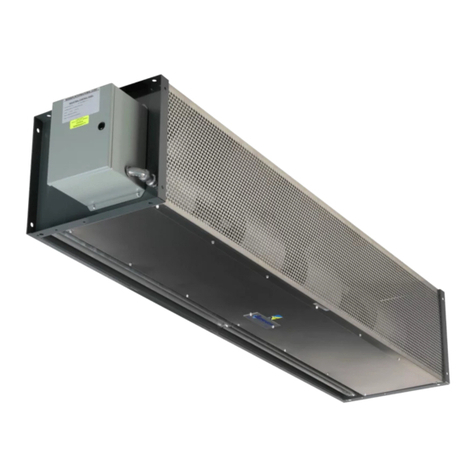
Berner
Berner BPT-RA 12 SD Instruction manual/safety instruction
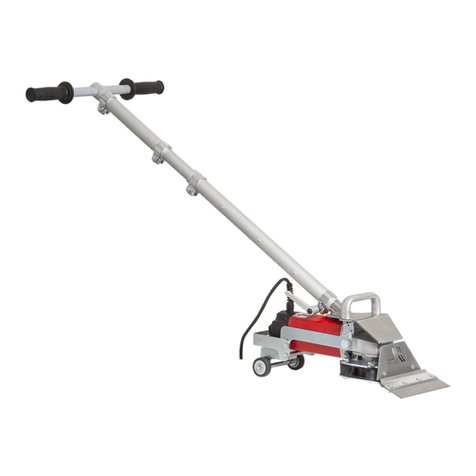
Roll
Roll Bullystripper Operation manual & spare parts list
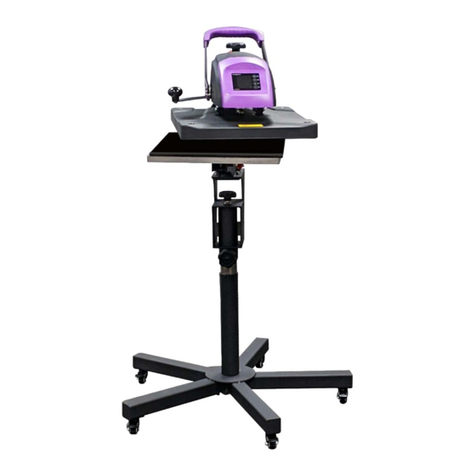
InkJetBiz
InkJetBiz XPress 1620SA SWING AWAY with Caddie user manual

Porter-Cable
Porter-Cable 7538 instruction manual
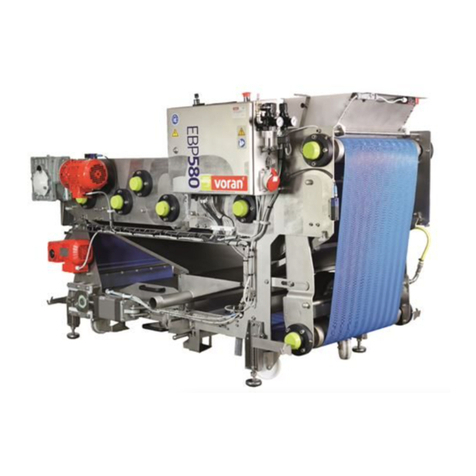
voran
voran EBP580 Translation of operating manual
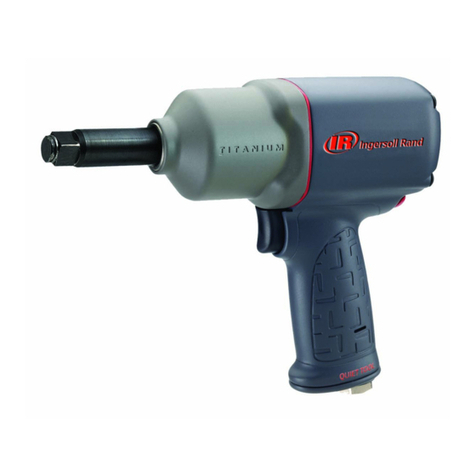
Ingersoll-Rand
Ingersoll-Rand 2135TI Instructions for use
